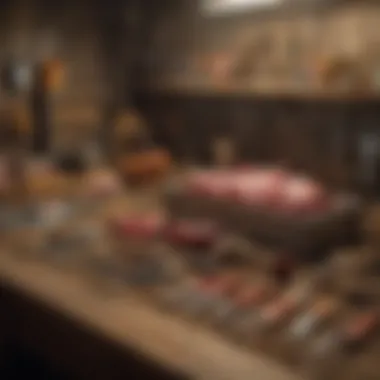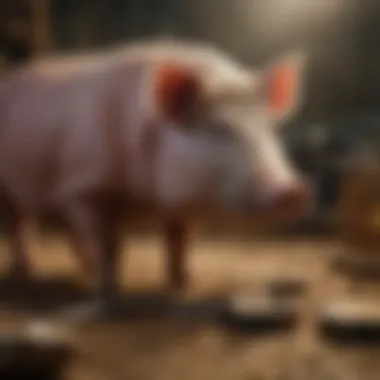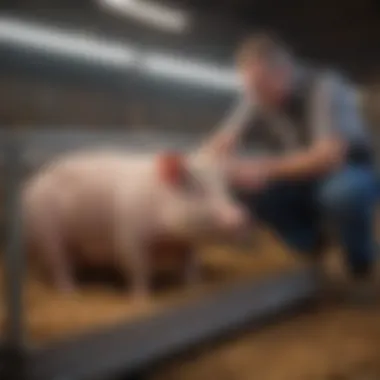Understanding the Hog Show Box: Essentials and Insights


Intro
The hog show box is a critical asset for anyone involved in hog showing, whether at local county fairs or larger livestock competitions. It acts as a mobile storage unit for supplies, tools, and equipment essential for preparing and presenting hogs in the best possible light. Understanding this tool's significance goes beyond mere functionality; it involves an appreciation of its role in livestock management, presentation, and overall success at shows.
Developing insights into the hog show box offers not only practical benefits for its users but also enhances the overall experience of exhibiting livestock. This exploration into the essential functions, design variations, and best practices surrounding the hog show box will provide a thorough understanding of its importance in agricultural practices.
Key Concepts and Terminology
Basic Definitions
The term hog show box refers to a specialized box designed to organize various materials required for hog showing. Commonly, these boxes include compartments for items such as grooming tools, feed, medications, and even awards. Each component within the box plays a role in maintaining the hog's health and appearance, ultimately influencing show performance.
Historical Context
Historically, livestock exhibitions date back centuries, with agricultural fairs establishing a platform for farmers to showcase their breeding successes and livestock management skills. Show boxes evolved over time, transitioning from simple wooden crates to more sophisticated storage solutions that cater to today’s needs. They reflect advances in livestock practices and the growing importance of presentation in competitive environments.
Recent Innovations and Trends
Technological Advancements
Modern hog show boxes are now being designed with technology in mind. Some models incorporate features like built-in scales for weight checks, or compartments that are easily sanitized. The inclusion of durable materials and weather-resistant designs also ensures longevity, making them more practical for outdoor events where conditions can be unpredictable.
Sustainable Practices
With increasing awareness of sustainability in agriculture, many manufacturers are turning to eco-friendly materials for constructing hog show boxes. These options not only reduce environmental impact but also appeal to a growing demographic concerned with sustainable farming practices.
Practical Applications and Techniques
Step-by-step Guides
Using a hog show box effectively involves organized packing and routine maintenance. Here are some key steps to ensure an optimal experience:
- Organize Supplies: Arrange tools and supplies based on their usage frequency, such as placing grooming tools at the top for easy access.
- Inspect Regularly: Check for any damaged items and replace them promptly to avoid complications during shows.
- Clean Thoroughly: After each event, ensure that the show box and its contents are appropriately cleaned to maintain hygiene.
Case Studies
Local Exhibitor Success: Several local exhibitors have shared their experiences indicating that the proper use of a well-organized show box improved their efficiency during competitions. By having everything at hand, they can focus on presenting their hogs rather than searching for misplaced items.
"The difference between a stress-free competition and a chaotic one often comes down to how well-prepared we are. A properly equipped hog show box is not merely a convenience; it's a necessity."
By advancing the understanding of the hog show box, this article serves to highlight its complexity and the thoughtfulness required in its utilization. There exists a ripple effect—higher quality presentation leads to better assessments by judges, ultimately impacting the success of the exhibitor.
Prolusion to the Hog Show Box
The hog show box plays an integral role in the world of competitive hog showing. It serves not only as a vessel for essential equipment but also as a way to enhance the overall experience for both exhibitors and the audience. Understanding this box's importance extends beyond its physical presence—it's about appreciating how it facilitates best practices in livestock management.
Definition and Purpose
The hog show box is, quite simply, a specialized container designed to store and organize equipment needed during hog shows. Its purpose is twofold: to keep everything in one place and to ensure that the exhibitor has quick and easy access to necessary tools.


Typically, a hog show box includes compartments for various items like grooming tools, health supplies, and feeding materials. This organization not only eases the stress of show day but also supports good animal management principles. By having everything organized, an exhibitor can focus more on presenting their hog effectively and less on searching for supplies.
Historical Context
The concept of a hog show box isn't new. Traditionally, livestock exhibitors have used some form of storage for their show-day essentials. However, the design and functionality of these boxes have evolved significantly.
Originally, exhibitors may have used simple wooden crates or bags to carry their supplies. Over time, this approach was replaced by more developed designs that consider both portability and accessibility. Today, some hog show boxes are created from durable plastic or metal with features like wheels for ease of transport. This history reflects the ongoing advancements in agricultural practices, emphasizing the increasing importance of efficiency in livestock management.
Understanding the evolution of the hog show box provides insight into its current role in the industry, serving as a reminder that practicality and convenience are key components in supporting the needs of farmers and enthusiasts alike.
Key Components of the Hog Show Box
The hog show box plays a critical role in the successful management and presentation of livestock during exhibitions. Understanding its key components helps farmers and enthusiasts ensure they are well-equipped to face the challenges of competitive hog showing. This section will explore the physical structure and functional elements that define a quality hog show box, focusing on their specific features, benefits, and considerations.
Physical Structure
Materials Used
The materials used in the construction of hog show boxes are essential to their durability and functionality. Common materials include steel, aluminum, and high-density polyethylene. These materials contribute to the box's structural integrity, allowing it to withstand rigorous usage over time. Steel and aluminum provide sturdiness, while high-density polyethylene offers a lightweight option, making transportation much easier. Each material has its own unique features. For instance, while steel is robust, it may be prone to rust if not properly maintained. Aluminum provides strength without the added weight but can be more expensive. High-density polyethylene, on the other hand, is resilient to weather conditions and easier to clean but might not offer the same level of protection as metal options.
Size and Capacity
The size and capacity of a hog show box are vital to its effectiveness. Typically, these boxes need to accommodate not just the hog but also the necessary supplies for showing and care. Most hog show boxes have a standard size that allows for comfortable movement of the animal, reducing stress before a show. A larger capacity can enable additional storage of grooming tools and supplies. However, one must balance the size with transportation considerations, as oversized boxes can be cumbersome to move. Smaller options can enhance mobility but may limit storage capacity, which can be a disadvantage during busy show days.
Accessibility Features
Accessibility features in a hog show box greatly enhance its usability. These can include ramps, adjustable heights, and containerized storage systems. Ramps allow hogs to enter and exit with minimal effort, crucial for their comfort and well-being. An adjustable height feature makes it easier for farmers to manage animals of different sizes. Containerized storage systems help keep supplies organized and readily accessible. However, while these features are beneficial, they can also increase the complexity of the design and potentially the cost. Ensuring that these features are easy to use and maintain is essential for maximizing the effectiveness of the show box in practice.
Functional Elements
Storage Solutions
Storage solutions in a hog show box are indispensable for organization. Compartmentalized designs help keep grooming tools, feeds, and health supplies neatly organized. The primary characteristic of effective storage solutions is their ability to facilitate quick access to essential items during a show. Common designs include built-in drawers, external racks, and removable bins. The advantage here is that these features promote efficiency and reduce the time spent searching for supplies. However, noise during movement can be an issue, and poorly designed storage can impede rather than help access.
Feeding and Watering Systems
The feeding and watering systems integrated within a hog show box are essential for animal care. These systems can range from simple feeding troughs to more sophisticated automatic watering devices. A key benefit of having these systems within the box is that they ensure hogs have access to food and water at all times, contributing to their health and welfare. Automatic systems can significantly reduce the effort required from the owner. On the downside, these systems can add to the initial cost of the show box and may require additional maintenance.
Health Management Supplies
Health management supplies are another crucial aspect of the hog show box. Items such as medications, first-aid kits, and grooming tools should be easily accessible. This contributes to the overall goal of maintaining animal health and readiness for shows. Providing these supplies in a designated area reinforces the idea of prioritizing animal welfare. The primary challenge is ensuring that these materials are stored properly to prevent contamination or damage, which can be a risk if not managed appropriately.
Types of Hog Show Boxes
The selection of a hog show box can significantly influence the overall experience for both the livestock and the handler. Understanding the types of hog show boxes available offers insights into how to select the right box based on need. Each type has its specific features and benefits, so it is vital to consider factors like mobility, customization, and specific use cases.
Portable vs. Stationary Designs
Portable hog show boxes are designed for easy transport. They typically have lightweight materials and collapsible features, allowing owners to relocate their setup with minimal hassle. These boxes are perfect for showing events held in diverse locations, enabling exhibitors to quickly set up and dismantle their stations without extensive effort. This flexibility allows for immediate adaptability to changing situations, such as different venue sizes and layouts.


However, portable designs often have limitations in terms of size and durability compared to stationary options. They might come with fewer features like additional storage or specialized compartments for various supplies.
In contrast, stationary hog show boxes provide a more robust solution for committed exhibitors. Built with sturdier materials, these hog show boxes can accommodate larger livestock and provide more integrated features, such as storage compartments and improved ventilation. Their stability makes them ideal for extended showing periods, ensuring that the hogs remain comfortable and secure.
When choosing between these designs, one must evaluate the typical environment where the box will be used. For frequent travelers, portable designs are likely the better choice. Conversely, if the box will remain in one location, investing in a stationary setup could enhance functionality and organization.
Custom-Built Options
Custom-built hog show boxes represent a significant step towards tailored solutions. These options allow exhibitors to specify their requirements based on particular needs of their livestock and showing style. Customization can include elements like size, color, storage solutions, and even branding.
Custom-built boxes have the advantage of precision. The exhibitor can design a box that suits the specific size and type of hog being shown. This ensures that all aspects such as comfortable space, adequate ventilation, and easy access for feeding, watering, and health checks are well catered for.
Furthermore, these bespoke boxes can integrate features that might be lacking in pre-manufactured designs. For example, additional compartments for grooming tools, medicines, or feeds can be added to enhance operational efficiency on show day. Customization also allows for unique aesthetic choices, creating a more professional presence at shows.
Overall, the decision between portable, stationary, and custom-built options largely depends on individual priorities and resources available. Always consider the specific needs of the livestock, the location of the exhibitions, and the exhibitor's preferences.
"A well-designed hog show box can not only enhance the welfare of the animals but also amplify the exhibitor's performance during shows." - Livestock Management Expert
Selecting the correct type of hog show box can lead to more successful show experiences, ensuring that both the hog and exhibitor are well-prepared and confident on display.
Best Practices for Using the Hog Show Box
Utilizing a hog show box effectively can significantly impact both the performance of the hog and the overall presentation. When practitioners focus on best practices, they ensure a smoother and more successful experience during livestock shows. These practices can facilitate better animal welfare, organized show day operations, and proper preparation techniques.
Preparation Techniques
Cleaning and Sanitizing
Cleaning and sanitizing the hog show box is crucial to maintain the health of the animals. This process eliminates harmful bacteria and viruses that can lead to illness. Ensuring a clean environment not only promotes the welfare of the hogs but also enhances their appearance and thus their performance on show day.
A key characteristic of cleaning and sanitizing in this context is regularity. It is beneficial to establish a routine cleaning schedule before and after each use. This habit ensures the box remains in a prime condition. A unique feature of this practice is the use of specialized cleaning agents and equipment. For instance, utilizing disinfectants specifically designed for livestock can be particularly effective. However, practitioners should consider the balance between effective cleaning and the safety of the hogs, as not all cleaning agents are suitable for use around animals.
Organizing Supplies
Organizing supplies within the hog show box aids in efficiency and reduces stress on show day. This practice contributes to better management by having all necessary equipment and materials easily accessible. The key characteristic of organizing supplies lies in creating designated spaces for each item. This approach ensures that everything from feeding equipment to grooming tools is in its proper place.
A significant advantage of organization is the time saved when preparing the hogs for judging. Clear labeling and systematic arrangements allow for quick retrieval under pressure. Moreover, a well-organized box can help in maintaining an overview of the supplies in use, reducing the likelihood of forgetting essential items. However, one must be cautious, as over-organizing can lead to clutter if it involves excessive containers or dividers.
Show Day Strategies
Transport Considerations
Transporting the hog show box requires planning to ensure that the hogs arrive safely and comfortably at the show venue. Important considerations include securing the show box within a transport vehicle, maintaining proper ventilation, and monitoring temperatures during transit.
A major characteristic of transport considerations is ensuring the stability of the box. Utilizing shock-absorbent materials or securing the box with straps can prevent unnecessary jostling during the journey. Such precautions help maintain the comfort of the animals and prevent inadvertent injuries or stress. This is beneficial since the calmer the hogs are before a show, the better they may perform.
Emergency Readiness
Preparing for emergencies is another essential aspect of using a hog show box. Having a contingency plan in place for potential issues—such as sudden illness or equipment failure—can mitigate risks and enhance safety. Emergency readiness should involve maintaining a stock of first aid supplies specifically for hogs. Knowing how to address common emergency issues is also vital.


The key characteristic of emergency readiness is adaptability. Practitioners should be prepared for unexpected situations by equipping their show boxes with necessary tools and supplies. One unique feature of being prepared might include having road maps to the nearest veterinary services or quick access to mobile phone numbers for local veterinarians. While good emergency planning is beneficial, it should be balanced to avoid overcrowding the show box with unnecessary items.
"Planning ahead and being prepared for emergencies is crucial in ensuring that both the livestock and the handlers can manage anything unexpected during a show."
Implementing these best practices for using the hog show box enables farmers and enthusiasts to optimize their show experience. By focusing on preparation and strategies for show day, they not only enhance the welfare of the animals but also maximize the effectiveness of their showing efforts, thus improving outcomes in competitive settings.
The Role of the Hog Show Box in Livestock Management
The hog show box plays a crucial role in the overarching system of livestock management, particularly for farmers and enthusiasts involved in competitive hog showing. It is not merely a storage unit; it is a multifaceted tool that directly influences the welfare and presentation of livestock during exhibitions. Understanding its role is imperative for maximizing effectiveness and ensuring the best outcomes in showcasing hogs. This section delves into how the hog show box elevates animal welfare while also facilitating an impressive presentation before judges and audiences alike.
Enhancing Animal Welfare
One of the primary functions of the hog show box is to enhance animal welfare. When properly utilized, this tool can create a safe and comfortable environment for the livestock. Key aspects include:
- Safety Features: The box generally includes design elements that keep the hog secure, reducing the risk of injury.
- Comfort: Adequate bedding and space can help alleviate stress for the animal, contributing to its well-being. This is crucial in ensuring hogs are calm and in good condition for shows.
- Health Management: With proper storage for health supplies, the hog show box allows for prompt access to veterinary care items. This ensures that any issues can be addressed quickly, maintaining the health of the animal during its stay at the show.
By prioritizing these factors, the show box directly impacts the welfare of the hog, ensuring it performs optimally while also adhering to ethical standards of livestock management. In a competitive environment, the well-being of the animal can significantly affect its presentation and performance, making this component vital.
Facilitating Effective Presentation
In addition to promoting welfare, the hog show box is integral to the effective presentation of pigs. The way an animal is presented can influence judges' decisions significantly in a show setting. Considerations include:
- Organization of Supplies: A well-organized show box allows for easy access to grooming tools and other necessities. Pre-show arrangements can be quickly executed, ensuring the hog is clean and ready for inspection.
- Show Readiness: The physical structure of the box allows for efficient use of space, making it easier to prepare the animal quickly. This preparedness can reduce last-minute scrambling, allowing for a calm atmosphere before presentations.
- Visual Appeal: A tidy, well-kept show box can enhance the overall visual impression of the exhibitors. It reflects professionalism and attention to detail, qualities that are often looked for by judges.
Effective presentation encompasses both the actual physical appearance of the hog and the conduct of the exhibitor. The hog show box thus serves a dual purpose in elevating both aspects.
In summary, the hog show box is more than just a functional tool. It is an essential component in the practices of livestock management that directly impacts animal welfare and the overall presentation of hogs. Understanding its functions allows farmers and enthusiasts to utilize it more effectively, ensuring that both animals and presentations are optimally prepared for competition.
Maintenance and Care of the Hog Show Box
The maintenance and care of the hog show box are critical aspects that cannot be overlooked. An effectively maintained hog show box extends the life of the equipment and enhances the welfare of the animals being shown. Regular upkeep ensures that all components function correctly and meet the standards expected in competitive environments. Additionally, prepared show boxes facilitate smooth operations during events, allowing participants to concentrate on their animals rather than equipment failures. Keeping the box clean and in good repair also reflects positively on the exhibitor's professionalism.
Cleaning Procedures
Keeping the hog show box clean is essential for both hygiene and functionality. Animals in close quarters are susceptible to diseases. Thus, having a strategy for cleaning can protect them from potential health issues. The cleaning process should ideally consist of the following steps:
- Empty the Contents: Remove all items from the box, including feed, bedding, and any other equipment.
- Wash the Surfaces: Use warm, soapy water to scrub the interior and exterior. A non-toxic detergent is recommended to avoid harmful residues.
- Sanitize: After washing, apply a suitable disinfectant to kill any remaining pathogens. It is crucial to follow the manufacturer's instructions when using chemical agents.
- Dry Thoroughly: Ensure all parts of the box are dry before storing or replacing items. Moisture can lead to mold and attract pests.
- Check for Residue: Pay close attention to corners and crevices where residues may build up. These areas require specific attention.
Regular cleaning not only maintains hygiene but also keeps the box organized. A clutter-free space prevents accidents and promotes efficient use of all components.
Repair and Upkeep
Repairs are an integral part of ensuring the longevity and efficiency of the hog show box. Various components may face wear and tear over time, thus regular inspections are important. Here are key aspects to focus on:
- Routine Inspections: Regularly check for any worn-out parts or damages. Common issues may include loose hinges or damaged latches.
- Replace Broken Items Promptly: Do not delay in addressing broken parts. Procrastination in repairs can lead to larger issues, such as loss of containment or structural failure.
- Lubricate Moving Parts: For components with moving parts, such as wheels or doors, applying suitable lubricants helps to maintain functionality.
- Evaluate for Upgrades: As technology evolves, consider upgrading certain components for enhanced functionality. Examples might include more efficient feeding systems or improved ventilation.
In summary, consistent maintenance and care for the hog show box significantly contribute to optimal livestock management. Ensuring a clean, functional, and reliable environment builds a foundation for successful shows, reflecting the dedication and responsibility of the exhibitors.
Ending: The Importance of the Hog Show Box
The hog show box is an integral part of the livestock exhibition scene. Its primary role extends beyond mere functionality to encompass the broader aspects of animal welfare and presentation during shows. Understanding this importance highlights how a well-designed and efficiently utilized hog show box can lead to better outcomes for both the animals and their handlers.
Future Innovations
As agricultural practices evolve, so too does the design of the hog show box. Future innovations may focus on enhancing the materials used for construction, ensuring they are more durable and environmentally friendly. Smart technology could also play a role, allowing for real-time monitoring of the animal's health and comfort. Features such as built-in temperature control and automated feeding systems might become standard. These advancements not only promise to facilitate better management of hogs but also aim to improve the showcasing experience, keeping both the animals and handlers at ease during events.















